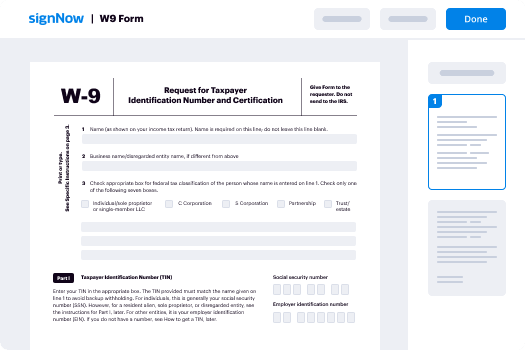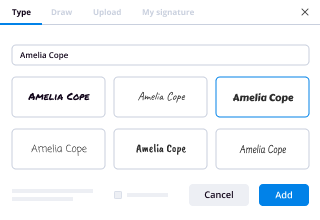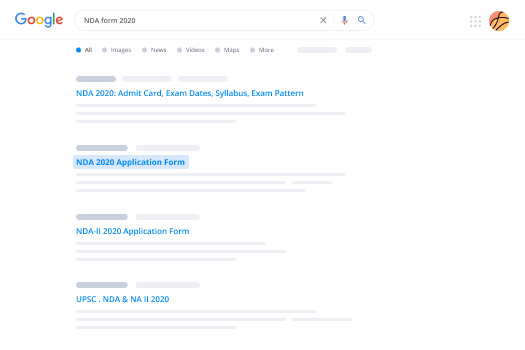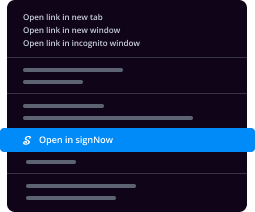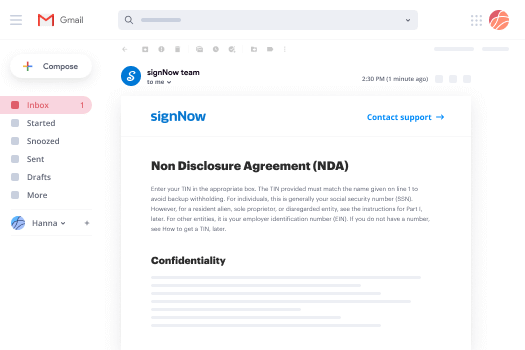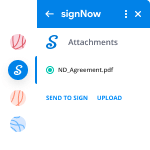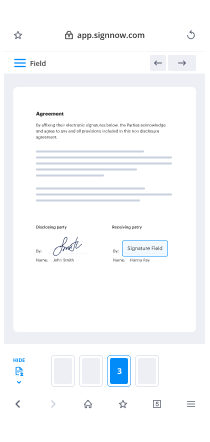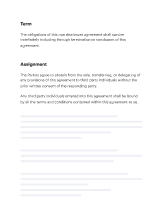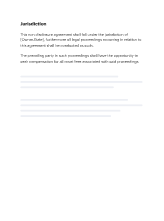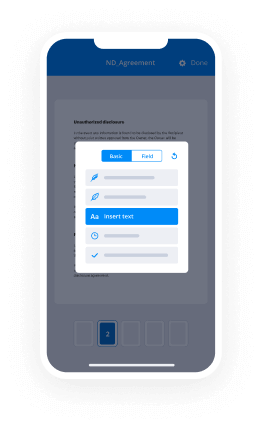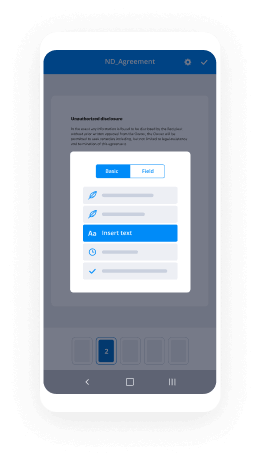At-Will Employment Agreement with Executive
Employment Agreement made on the ________________ (date) , hereinafter
sometimes referred to as the Effective Date , between _____________________ (Name
of Employee) of ________________________________________________________
________________ (street address, city, state, zip code) , referred to herein as
Employee , and ________________________ (Name of Employer) , a corporation
organized and existing under the laws of the state of ______________, with its principal
office located at _________________________________________________________
____________ (street address, city, state, zip code) , referred to herein as Company .
Whereas, Employee has been employed by the Company on an at-will basis as
__________________________ (Name of Office) , and Employee and the Company
desire that Employee continue working for the Company in this capacity; and
Whereas, Employee and Company further desire to enter into this written
Employment Agreement (this Agreement ) and to be bound by the terms and conditions
of this Agreement;
I. Capacity and Duties
A. At-Will Employment
Company has employed and shall continue to employ Employee pursuant
to this Agreement on an at-will basis. Employee's employment under this
Agreement with the Company is for an unspecified duration and may be
terminated at any time by either Employee or the Company, for any or no reason,
with or without prior notice, except as described in Section III .
B. Capacity and Duties
Employee shall be subject to the supervision and control of the Company's
Chairman of the Board and Chief Executive Officer and the Board of Directors,
and agrees to perform such duties and responsibilities normally associated with
the position of ________________________ (Name of Office) and as may
reasonably be assigned to Employee from time to time by the Company's
Chairman of the Board and Chief Executive Officer or by the Company's Board of
Directors. Employee is required to work those hours necessary to perform
properly such duties and responsibilities normally associated with the position of
______________________ (Name of Office) and as may reasonably be
assigned to Employee from time to time pursuant to this Agreement.
Notwithstanding the foregoing in this Paragraph B , after a Closing Date (as
defined below in this Agreement), Employee shall have such title, duties and
responsibilities and be subject to the supervision and control of such persons as
may be, after taking into account the fact that a Change of Control (as defined
below in this Agreement) has occurred and other relevant facts and
circumstances, determined by the Company in its sole discretion from time to
time.
2. Compensation and Fringe Benefits
A. Compensation
1. Base Salary
As base compensation for Employee's services under this
Agreement, the Company shall pay to Employee an initial salary at an
annual rate of $___________ (the Base Salary ). Employee's Base Salary
will be payable in accordance with the Company's regular payroll practices
in effect from time to time during Employee's employment, but not less
than monthly. Employee's Base Salary shall be reviewed by the Company
no less often than annually and shall be adjusted (upward, and with the
consent of Employee, downward) upon review as determined by the
Company.
2. Bonus
a. Incentive Bonus
Employee shall be eligible to receive an annual incentive
bonus pursuant to and in accordance with the _________________
_____________ (Name of Company) Incentive Compensation
Plan (the Plan ) and subject to the Plan's eligibility requirements and
other terms, conditions and restrictions (the Incentive Bonus );
provided, however, that the Plan and its terms are subject to
change and the Plan may be modified or eliminated in accordance
with the terms of the Plan.
b. Additional Bonuses
Employee shall not be entitled to receive any other bonuses
from the Company; provided, however, that the Company may
award Employee additional bonuses as it determines are
appropriate in its sole discretion (the Additional Bonuses ).
B. Fringe Benefits
1. Insurance and Retirement Benefits
Employee (and his eligible dependents, where applicable) shall be
eligible to participate in the Company's insurance and health benefit plans
to the extent and upon the terms offered to the Company's other senior
executive officers, including but not limited to any 401(k) plans,
supplemental executive retirement plans (“SERP”), savings plans,
incentive plans, stock purchase plans, stock incentive plans, retirement
plans or deferred compensation plans, subject to the plans' respective
eligibility requirements and other terms, conditions, restrictions and
exclusions. To the extent applicable, Employee shall be entitled to
participate in such plans as a Tier ________ (number) employee. Nothing
in this Agreement shall preclude or otherwise restrict the Company's right
to modify or terminate any insurance or other benefit plan, policy or
program as it deems appropriate in its sole discretion.
2. Vacation
Employee shall be entitled to _____ (number of weeks) weeks of
paid vacation during each full calendar year of his employment in
accordance with the terms and provisions of the Company's policies and
practices in effect from time to time.
3. Expense Reimbursement
Company shall reimburse Employee for all reasonable expenses
incurred by him in connection with the performance of his duties under this
Agreement in accordance with the Company's regular reimbursement
policies as in effect from time to time and upon receipt of itemized
vouchers and such other supporting information as the Company may
reasonably require. The reimbursement of any such eligible expense shall
be made on or before the last day of the calendar year next following the
calendar year in which the expense was incurred.
4. Transportation Allowance
Employee shall receive a monthly transportation allowance in the
amount of $_____________ (the Transportation Allowance ). The
Transportation Allowance shall be payable in accordance with the
Company's regular payroll practices in effect from time to time.
5. Additional Benefits
Employee shall be eligible to participate in such other fringe
benefits upon the terms offered to the Company's other senior executive
officers and subject to the terms, conditions, restrictions and exclusions of
any such fringe benefit plans or programs.
6. Indemnification
a. The Company shall maintain a directors’ and officers’ liability
insurance policy while Employee is employed by the Company
pursuant to this Agreement to the extent such a policy is available
at commercially reasonable rates as determined by the Board of
Directors. Employee shall be entitled to coverage under such policy
as an officer of the Company, subject to the policy's terms,
conditions, restrictions and exclusions.
b. In addition to the Company's obligation to maintain such
insurance, the Company shall, to the fullest extent permitted by and
in accordance with applicable law as it may be amended from time
to time, indemnify Employee in connection with any claim, action,
suit, investigation or proceeding arising out of or relating to
performance by Employee of services for, or any action of
Employee as a director, officer, member, manager or employee of,
the Company, or of any other person or enterprise for whom
Employee is serving at the request of the Company as a director,
officer, member, manager or employee. Expenses reasonably
incurred by Employee in defending such a claim, action, suit,
investigation or proceeding shall, to the extent permitted by
applicable law, be paid by the Company in advance of the final
disposition of such a claim, action, suit, investigation or proceeding
upon receipt of a written undertaking by or on behalf of Employee
to repay such amounts if it shall ultimately be determined that
Employee is not entitled to indemnification by the Company as
provided in this Paragraph 6 . Notwithstanding anything in the
foregoing to the contrary, in no event will Employee be entitled to
any indemnification (including but not limited to any advancement
of fees or expenses) pursuant to this ________________________
(Name of Office) Paragraph 6 with respect to any action, suit or
proceeding brought or made by Employee against the Company or
any of its affiliates or officers, directors, employees or agents. The
provisions of this Paragraph 6 shall be in addition to any
indemnification rights Employee may have by law, contract, charter,
by-law, policy of insurance or otherwise.
C. Payments After Termination of Employment
1. Termination for Any Reason
Regardless of the reason for the termination of Employee's
employment, whether by Employee or the Company, whether or not due
to Employee's death or Disability (as that term is defined in Section III , and
whether or not for Cause (as that term is defined in Section III , or for
Good Reason (as that term is defined in Section III ), Employee (or his )
estate) will receive unpaid Base Salary for any days actually worked by
Employee prior to the termination of his employment, expense
reimbursement for all reasonable expenses incurred by him in connection
with the performance of his duties prior to the termination of his
employment, and payment for accrued but unused vacation pay to the
extent Employee may be eligible for such payment under the Company's
policies.
2. Termination by the Company Without Cause or Due to
Employee's Death, Disability or by Employee for Good Reason
(i) Subject to the terms and conditions set forth in Subparagraph 4
of this Paragraph C , (i) if Employee is terminated by the Company without
Cause (as that term is defined in Section III ) or due to his Disability (as
that term is defined in Section III) , (ii) if Employee terminates his
employment with the Company for Good Reason (as that term is defined
in Section III) , or (iii) ________ (his/her) employment with the Company
terminates due to his death, then in addition to the payments described in
Subparagraph 1 above:
a. The Company shall pay Employee any accrued but unpaid
Incentive Bonus with respect to any completed Plan Year (as that
term is defined in the Plan) ending prior to the date on which
Employee's employment terminates, to be paid in accordance with
the terms of the Plan. Payment of any such amount shall be made
at the same time these amounts would have been paid if
Employee's employment had not terminated.
b. The Company shall pay Employee a prorated bonus
calculated by multiplying the higher of (x) the sum of the Incentive
Bonus and any Additional Bonuses Employee received with respect
to the last full Company fiscal year during which Employee was
employed by the Company (and for which bonus determinations
have been made), or (y) the average of the Incentive Bonuses and
any Additional Bonuses Employee received during each of the last
two full fiscal years during which Employee was employed by the
Company, by a fraction, the numerator of which is the number of
days in the current fiscal year through Employee's termination date,
and the denominator of which is 365; provided, however, that the
sum of any Incentive Bonuses and any Additional Bonuses
Employee received in respect of Fiscal __________ (identification
of year) shall be deemed to be $__________ (dollar amount of
deemed total of annual incentive bonuses and additional
bonuses) regardless of the actual amount of such bonuses. This
amount will be paid in a single lump sum as soon as practicable
following Employee's termination of employment; provided,
however, that if any portion of such payment constitutes a payment
of nonqualified deferred compensation for purposes of Section
409A of the Internal Revenue Code, and the payment of any
portion of such payments would be in violation of Section 409A(a)
(2)(B)(i) of the Internal Revenue Code, then, to the extent required
to avoid a violation of Section 409A(a)(2)(B)(i) of the Internal
Revenue Code, such payment shall be deferred until the six-month
anniversary date of Employee's termination. Deferred benefits will
be paid with interest at the lesser of the prime rate (as published
from time to time in the Money Rates section of the Wall Street
Journal) and _______ (interest rate) %.
c. Company shall pay Employee a severance equal to the sum
of (A) the higher of (x) Employee's annual Base Salary (at the rate
in effect on the date of termination), or (y) the average of the annual
Base Salary Employee received during each of the last ______
(number of years) full fiscal years during which Employee was
employed by the Company, and (B) the higher of (x) the sum of the
Incentive Bonus and any Additional Bonuses Employee received
with respect to the last full Company fiscal year during which
Employee was employed by the Company, or (y) the average of the
Incentive Bonuses and any Additional Bonuses Employee received
during each of the last _____ (number of years) full fiscal years
during which Employee was employed by the Company; provided,
however, that the sum of any Incentive Bonuses and any Additional
Bonuses Employee received in respect of Fiscal __________
(identification of year) shall be deemed to be $_________ (dollar
amount of deemed total of annual incentive bonuses and
additional bonuses) regardless of the actual amount of such
bonuses, and provided further that any amounts payable to
Employee or his estate, surviving spouse, eligible dependents or
other beneficiaries as a death or disability benefit under the
Company's SERP (the SERP Payment ) shall be deducted from the
amounts otherwise payable pursuant to this subparagraph c . This
amount will be paid in a single lump sum as soon as practicable
following Employee's termination of employment; provided,
however, that if any portion of such payment constitutes a payment
of nonqualified deferred compensation for purposes of Section
409A of the Internal Revenue Code, and the payment of any
portion of such payments would be in violation of Section 409A(a)
(2)(B)(i) of the Internal Revenue Code, then, to the extent required
to avoid a violation of Section 409A(a)(2)(B)(i) of the Internal
Revenue Code, such payment shall be deferred until the six-month
anniversary date of Employee's termination. Deferred benefits will
be paid with interest at the lesser of the prime rate (as published
from time to time in the “Money Rates” section of the Wall Street
Journal) and _______ (interest rate) %. If the full amount of the
SERP Payment is not actually paid to Employee or his estate,
surviving spouse, eligible dependents or other beneficiaries within
_______ (number) days after the termination of Employee's
employment giving rise to the right to receive payment under this
subparagraph c , then within ______ (number) days after such
termination, the Company shall pay to Employee or his estate,
surviving spouse, eligible dependents or other beneficiaries an
amount equal to the difference between the full amount of the
SERP Payment and any portion of the SERP Payment previously
paid. If, subsequent to the payment of any such difference,
Employee or his estate, surviving spouse, eligible dependents or
other beneficiaries receive any payment on account of any unpaid
portion of the SERP Payment, then within ______ (number) days
after receipt of any such payment, the recipient shall pay such
amount to the Company.
d. The Company shall reimburse Employee (or his surviving
spouse or eligible dependents, in the event of Employee's death)
for the full cost of continuation coverage under the Company's
group health plan pursuant to the Consolidated Omnibus Budget
Reconciliation Act ( COBRA ) at the same level of coverage
Employee (and his ) eligible dependents, where applicable) had as
of Employee's termination date (collectively, COBRA Payments ) for
up to ______ (number) months, so long as Employee (or
Employee's eligible dependents) remain eligible for continuation
coverage under COBRA and provided that Employee is eligible for
and timely elects continuation coverage under COBRA and
continues to make COBRA payments on a timely basis. If
Employee provides to the Company within _______ (number) days
after his termination written notice that he elects to receive the
COBRA Payments in a lump sum, then as soon as practicable after
such notice the Company shall pay to Employee a lump sum equal
to the aggregate amount of COBRA Payments Employee would
have received as reimbursement of COBRA payments for the full
initial _____ (number) -month period of COBRA continuation
coverage (less any COBRA payments made by the Company for
which Employee is required to reimburse the Company). Employee
acknowledges that this benefit (whether paid in a lump sum or in
installments) may be taxable to Employee. Payment of
reimbursements pursuant to this subparagraph d shall in all cases
be made in a time and manner consistent with the requirements of
Treasury Regulations regarding payment of reimbursements under
Internal Revenue Code Section 409A. If Employee (or his ) surviving
spouse or eligible dependents, in the event of Employee's death) is
eligible for COBRA continuation coverage beyond the initial
_____ (number) -month period of COBRA continuation coverage
( Extended COBRA Coverage ), so long as Employee (or
Employee's eligible dependents) timely elects continuation of
coverage under COBRA and makes the COBRA payments on a
timely basis, Employee (and his eligible dependents, where
applicable) may continue the Extended COBRA Coverage at
Employee's sole cost and expense, which cost and expense will not
be reimbursed by the Company.
e. At such time as Employee or Employee's eligible
dependents become ineligible for continuation coverage under the
Company's group health plan pursuant to COBRA, the Company
shall take reasonable steps to assist Employee and Employee's
eligible dependents in securing alternative health coverage on a
fully insured basis (which may be in the form of conversion
coverage, if such coverage is available from any insurance carrier
which is at that time providing coverage or services in connection
with a Company group health plan) or, if a determination is made
by the Company in its sole discretion that coverage can be made
available to Employee and Employee's eligible dependents after
Employee or Employee's eligible dependents cease to be eligible
for continuation coverage under COBRA without resulting in the
health benefits becoming taxable to Employee, then the Company
will permit Employee and Employee's eligible dependents to
continue to participate in the Company's group health plan with
payment of premiums comparable to those required under either
the Company's plan, or COBRA, at the option of the Company.
Payment of premiums under any such arrangement will be made by
Employee from Employee's own funds and will not be subject to
reimbursement by the Company.
f. Unless otherwise specifically provided to the contrary in the
applicable grant or award document (as such grant or award
document may be modified by the Company), all of Employee's
unvested options to acquire Company stock and unvested
restricted Company stock shall immediately vest, with such
accelerated vesting to be otherwise in accordance with the terms
and conditions of the applicable grant or award document and plan.
(The provisions of this subparagraph f shall be considered to be an
amendment to any applicable grant or award document to the
extent necessary to implement the terms of this subparagraph f .)
3. Termination in Connection with a Change of Control.
Subject to the terms and conditions set forth in the following
Subparagraph 4 and subject to the occurrence of the Closing Date with
respect to the subject Change of Control, if (x) the Company terminates
Employee's employment for any reason (including, but not limited to,
Disability) or Employee's employment terminates due to Employee's death
during the period beginning _____ (number) days prior to a Change of
Control (as defined in Section III ) and ending on the applicable Closing
Date, (y) the Company terminates Employee's employment with the
Company for any reason (including, but not limited to, Disability) or
Employee's employment terminates due to Employee's death within one
year following the applicable Closing Date, provided that Employee was
employed by the Company on the applicable Closing Date, or (z)
Employee terminates Employee's employment with the Company for: (1)
Good Reason (provided, however, that solely for purposes of this
Subparagraph 3 , Good Reason shall not include the facts or
circumstances described in clause (ii) of the definition of Good Reason set
forth in Section III ) within one year following the Closing Date, provided
that Employee was employed by the Company on the applicable Closing
Date, or (2) for any reason within ______ (number) days immediately
preceding the one-year anniversary of the Closing Date, provided that
Employee was employed by the Company on the applicable Closing Date,
then in addition to the payments describe in Subparagraph 2 of this
Paragraph C : the Company shall pay Employee (or his estate, surviving
spouse, eligible dependents or other beneficiaries, in the event of
Employee's death) severance in an amount that is equal to ______
(number) Employee's average total compensation (including Base Salary,
Incentive Bonus and Additional Bonuses), calculated by determining the
average (mean) total cash compensation Employee earned for the most
recent _______ (number of years) full fiscal years worked prior to
Employee's termination to exceed $___________ of total compensation
for any one year, in order that such calculation is made on a basis
consistent with the definition of recognized compensation under the
Company's SERP as it exists on the effective date of this Agreement. If
severance is payable pursuant to this Subparagraph 3 as a result of
Employee's death or Disability, any amount payable as described in this
Subparagraph 3 will be reduced by any amount that is payable to
Employee or his estate, surviving spouse, eligible dependents as a death
or disability benefit under the Company's SERP (the COC SERP
Payment ). The amount payable under this Subparagraph 3 will be paid
in a single lump sum as soon as practicable following Employee's
termination of employment or the applicable Closing Date, if later;
provided, however, that if any portion of such payment constitutes a
payment of nonqualified deferred compensation for purposes of Section
409A of the Internal Revenue Code, and the payment of any portion of
such payments would be in violation of Section 409A(a)(2)(B)(i) of the
Internal Revenue Code, then, to the extent required to avoid a violation of
Section 409A(a)(2)(B)(i) of the Internal Revenue Code, such payment
shall be deferred until the six-month anniversary date of Employee's
termination. Deferred benefits will be paid with interest at the lesser of the
prime rate (as published from time to time in the “Money Rates” section of
the Wall Street Journal) and ________ (interest rate) %. If the full amount
of the COC SERP Payment is not actually paid to Employee or his estate,
surviving spouse, eligible dependents or other beneficiaries within _____
(number) days after the termination of Employee's employment giving rise
to the right to receive payment under this Subparagraph 3 or the
applicable Closing Date, if later, then within ______ (number) days after
such termination the Company shall pay to Employee or his estate,
surviving spouse, eligible dependents or other beneficiaries an amount
equal to the difference between the full amount of the COC SERP
Payment and any portion of the COC SERP Payment previously paid. If,
subsequent to the payment of any such difference, Employee or his
estate, surviving spouse, eligible dependents receives any payment on
account of any unpaid portion of the COC SERP Payment, then within
_____ (number) days after receipt of any such payment, the recipient
shall pay such amount to the Company. Notwithstanding anything in the
foregoing to the contrary, any amounts paid pursuant to Subparagraph
2(c) of this Paragraph C shall be deducted from amounts payable
pursuant to this Subparagraph 3 .
4. Termination Agreement
Employee shall receive the benefits set forth in Subparagraph 2 or
3 of this Paragraph C if and only if (x) Employee (or his ) estate, if
Employee's employment terminates due to his death) duly executes and
returns to the Company (and does not revoke if a revocation period is
included in the sole discretion of the Company) a termination agreement
(the Termination Agreement) substantially in the form attached to this
Agreement as Exhibit A , as such form may be modified by the Company
in its reasonable discretion solely to address developments in the law
including legal claims that came into existence after the date of this
Agreement; and (y) Employee complies in all material respects with his
obligations under this Agreement and the Termination Agreement.
5. No Mitigation
In no event shall Employee be obligated to seek other employment
or take any other action by way of mitigation of the amounts payable to
Employee under any of the provisions of this Agreement, and such
amounts shall not be reduced whether or not Employee obtains other
employment.
III. Termination of Employment
A. Death of Employee
Employee's employment under this Agreement shall immediately
terminate upon his death.
B. Employee's Disability
Employee's employment under this Agreement may be terminated by the
Company in the event of Employee's Disability, which shall mean Employee's
inability, for a total of ______ (number) weeks or more in any rolling ______
(number) -month period to perform the essential duties of Employee's position,
with any reasonable accommodation required by law, due to a mental or physical
impairment which substantially limits one or more major life activities. The
determination as to whether Employee has a Disability shall be made by a
physician selected by the Company, and Employee agrees to submit to
reasonable medical examinations upon the request and at the expense of the
Company.
C. Termination for Cause
Company may terminate Employee's employment at any time for Cause ,
which for purposes of this Agreement shall mean any of the following: (i) self-
dealing, willful misconduct, fraud, misappropriation, embezzlement, dishonesty,
or misrepresentation (other than a good faith dispute over an expense account
charge that is of an immaterial and insignificant amount); (ii) being charged by
governmental authorities with or convicted of a felony; (iii) material failure of
Employee to perform his known duties and responsibilities to the Company which
persists for more than ______ (number) days after written notice or which recurs
(i.e., the same or substantially similar matter which has been cured after written
notice from the Company occurs again within the succeeding ______ (number) -
month period); (iv) gross negligence which persists for more than _______
(number) days after written notice from the Company or which recurs; (v) any
violation of the Company's Code of Business Conduct and Ethics (as it may be
amended, restated, or replaced from time to time) which causes, or is likely to
cause, a material or significant injury to the Company or which recurs; (vi)
violation in any material respect by Employee of any policy, rule, or reasonable
direction or regulation of the Company which persists for more than _______
(number) days after written notice or which recurs; (vii) any violation by
Employee of the provisions of the Non-Competition and Confidentiality
Agreement described in Section IV below; or (viii) any violation by Employee of
any material provision of this Agreement (other than the Non-Competition and
Confidentiality Agreement) which persists for more than ______ (number) days
after written notice or which recurs.
D. Termination without Cause
Company may terminate Employee's employment at any time and for any
or no reason (i.e., without Cause) by providing Employee with ______ (number)
days prior written notice, which notice the Company can waive, in whole or in
part, in its sole discretion, by paying Employee for such time; provided, however,
the Company may terminate Employee's employment immediately if there is
Cause (as defined in Paragraph C of this Section III) , in the event of
Employee's Disability (as defined in Paragraph B ) and in the event of
Employee's death.
E. Termination for Good Reason
Employee may terminate Employee's employment at any time for “Good
Reason,” which for purposes of this Agreement shall mean: (i) reduction of
Employee's Base Salary, except as agreed to by Employee in accordance with
Section 2 , Subparagraph A(1) ; (ii) the assignment to Employee by the Chief
Executive Officer or the Board of Directors of duties which represent a material
decrease in responsibility and are materially inconsistent with the duties
associated with Employee's position, or any material reduction in Employee's job
title, or a material negative change in the level of employee to whom Employee
reports; (iii) the Company's requiring Employee to be based at any office or
location other than in _______________ (name of city) , _______________
(name of state) , or within _________ (number of miles) miles of the
_______________ (name of city) metropolitan area; or (iv) any material breach
of this Agreement by the Company; provided, however, that Good Reason shall
not exist under (i) through (iv) above unless and until Employee provides the
Company with written notice of the condition that Employee believes to constitute
Good Reason and the Company fails to cure the condition within ______
(number) days after receiving such written notice or such condition recurs.
F. Termination for Other Than Good Reason
Employee may terminate Employee's employment at any time and for
other than Good Reason by providing the Company with _____ (number) days'
prior written notice, which notice period the Company may waive, in whole or in
part, in its sole discretion, by paying Employee for such time.
G. Change of Control and Closing Date
A Change of Control shall be deemed to have occurred upon the earliest
to occur of the following dates:
1. The date the stockholders of the Company (or the Board of
Directors, if stockholder action is not required) approve a plan or other
arrangement pursuant to which the Company will be dissolved or
liquidated;
2. The date the stockholders of the Company (or the Board of
Directors, if stockholder action is not required) approve a definitive
agreement to sell or otherwise dispose of substantially all of the assets of
the Company;
3. The date the stockholders of the Company (or the Board of
Directors, if stockholder action is not required) and the stockholders of the
other constituent corporation (or its board of directors if stockholder action
is not required) have approved a definitive agreement to merge or
consolidate the Company with or into such other corporation, other than,
in either case, a merger or consolidation of the Company in which holders
of shares of the Company's Common Stock immediately prior to the
merger or consolidation will have at least a majority of the voting power of
the surviving corporation's voting securities immediately after the merger
or consolidation, which voting securities are to be held in the same
proportion as such holders' ownership of Common Stock of the Company
immediately before the merger or consolidation; or
4. The date any entity, person or group, within the meaning of Section
13(d)(3) or Section 14(d)(2) of the Exchange Act (other than: (A) the
Company or any of its subsidiaries or any employee benefit plan (or
related trust) sponsored or maintained by the Company or any of its
subsidiaries, (B) ___________________ (name of primary shareholder)
or family members of ___________________ (name of primary
shareholder) (all such persons being referred to as “_________________
(name of primary shareholder) Family Members”), (C) any entity a
majority of the equity in which is owned by ___________________ (name
of primary shareholder) Family Members, or (D) any trust as to which a
majority of the beneficiaries are _____________________ (name of
primary shareholder) Family Members), shall have become the
beneficial owner of, or shall have obtained voting control over, more than
50% of the outstanding shares of the Company's common stock. As used
in this Agreement, the term Closing Date means the date, if any, on which
a transaction that is treated as a Change of Control is consummated.
H. Non-Competition and Confidentiality Agreement
Termination of Employee's employment either by Employee or the
Company, whether with or without Cause, and whether or not due to Employee's
death or Disability, shall not release Employee from Employee's obligations and
restrictions under the Non-Competition and Confidentiality Agreement referred to
in Section Four below except to the extent specifically provided in that
agreement.
IV. Non-Competition and Confidentiality
The terms of this Agreement are contingent upon Employee's execution of a
Non-Competition and Confidentiality Agreement in the form attached to this Agreement
as Exhibit B . Employee's failure to execute the Non-Competition and Confidentiality
Agreement on or before this Agreement's Effective Date will invalidate this Agreement.
V. Miscellaneous
A. Special Tax Provision; Section 280G
1. Anything in this Agreement to the contrary notwithstanding and
except as set forth below, if it shall be determined that any payment or
distribution by the Company to or for the benefit of Employee (whether
paid or payable or distributed or distributable pursuant to the terms of this
Agreement or otherwise, but determined without regard to any additional
payments required under this Paragraph A ) (a Payment) would be subject
to the excise tax imposed by Section 4999 of the Internal Revenue Code
or any Interest or Penalties (as defined below) are incurred by Employee
with respect to such excise tax (such excise tax, together with any such
Interest or Penalties, are collectively referred to as the Excise Tax ), then
Employee shall be entitled to receive an additional payment (a Gross-Up
Payment ) in an amount such that after payment by Employee of all taxes
(including any Interest or Penalties imposed with respect to such taxes),
including, but not limited to, any income taxes (and any Interest or
Penalties imposed with respect to such taxes) and Excise Tax imposed
upon the Gross-Up Payment, Employee retains an amount of the Gross-
Up Payment equal to the Excise Tax imposed upon the Payments.
Notwithstanding the foregoing provisions of this Subparagraph 1, if it
shall be determined that Employee is entitled to a Gross-Up Payment, but
that the Payments do not exceed 110% of the greatest amount (the
Reduced Amount) that could be paid to Employee such that the receipt of
Payments would not give rise to any Excise Tax, then no Gross-Up
Payment shall be made to Employee and the Payments, in the aggregate,
shall be reduced to the Reduced Amount. For purposes of this Agreement,
the term Interest or Penalties refers only to amounts of interest or
penalties imposed under applicable provisions of the Internal Revenue
Code with respect to excise taxes imposed on Employee pursuant to
Section 4999 of the Code, and only to the extent such amounts of interest
or penalties are attributable to errors in calculation of amounts considered
to be, or potentially considered to be excess parachute payments (as that
term is used for purposes of Section 280G of the Internal Revenue Code)
or are attributable to the Company's determination to contest claims or
assessments of such excise taxes by the Internal Revenue Service.
2. All determinations required to be made under this Paragraph A,
including whether and when a Gross-Up Payment is required and the
amount of such Gross-Up Payment and the assumptions to be use in
arriving at such determination, shall be made by such certified public
accounting firm as may be designated by the Company (the Accounting
Firm ) which shall provide detailed supporting calculations both to the
Company and Employee within ________ (number) business days of the
receipt of notice from Employee that there has been a Payment requiring
a Gross-Up Payment, or such earlier time as is requested by the
Company. If the Accounting Firm is serving as accountant or auditor for
the individual, entity or group effecting the Change of Control or the
Accounting Firm refuses to make the required determinations, the
Company shall appoint another nationally recognized accounting firm to
make the determinations required under this Agreement (which
accounting firm shall then be referred to as the Accounting Firm under this
Agreement). All fees and expenses of the Accounting Firm shall be borne
solely by the Company. Any Gross-Up Payment, as determined pursuant
to this Paragraph G , shall be paid by the Company to Employee within
______ (number) days of the receipt of the Accounting Firm's
determination. Any determination by the Accounting Firm shall be binding
upon the Company and Employee, absent manifest error. As a result of
the uncertainty in the application of Section 4999 of the Internal Revenue
Code at the time of the initial determination by the Accounting Firm under
this Agreement, it is possible that Gross-Up Payments which will not have
been made by the Company should have been made ( Underpayment ),
consistent with the calculations required to be made under this
Agreement. If the Company exhausts its remedies pursuant to
Subparagraph 3 below and Employee subsequently is required to make a
payment of any Excise Tax, the Accounting Firm shall determine the
amount of the Underpayment that has occurred and any such
Underpayment shall be promptly paid by the Company to or for the benefit
of Employee.
3. Employee shall notify the Company in writing of any claim by the
Internal Revenue Service that, if successful, would require the payment by
the Company of the Gross-Up Payment. Such notification shall be given
as soon as practicable but no later than _______ (number) business days
after Employee is informed in writing of such claim and shall apprise the
Company of the nature of such claim and the date on which such claim is
requested to be paid. Employee shall not pay such claim prior to the
expiration of the _____ (number) -day period following the date on which it
gives such notice to the Company (or such shorter period ending on the
date that any payment of taxes with respect to such claim is due). If the
Company notifies Employee in writing prior to the expiration of such period
that it desires to contest such claim, Employee shall:
a. Give the Company any information reasonably requested by
the Company relating to such claim;
b. Take such action in connection with contesting such claim as
the Company shall reasonably request in writing from time to time,
including but not limited to accepting legal representation with
respect to such claim by an attorney reasonably selected by the
Company;
c. Cooperate with the Company in good faith in order
effectively to contest such claim; and
d. Permit the Company to participate in any proceedings
relating to such claim; provided, however, that the Company shall
bear and pay directly all costs and expenses (including additional
Interest or Penalties) incurred in connection with such contest and
shall indemnify and hold Employee harmless, on an after-tax basis,
for any Excise Tax or additional income tax (including Interest or
Penalties with respect to such tax) imposed as a result of such
representation and payment of costs and expenses. Without
limitation on the foregoing provisions of this Paragraph A , the
Company shall control all proceedings taken in connection with
such contest and, at its sole option, may pursue or forgo any and all
administrative appeals, proceedings, hearings and conferences
with the taxing authority in respect of such claim and may, at its
sole option, either direct Employee to pay the tax claimed and sue
for a refund or contest the claim in any permissible manner, and
Employee agrees to prosecute such contest to a determination
before any administrative tribunal, in a court of initial jurisdiction
and in one or more appellate courts, as the Company shall
determine; provided, however, that if the Company directs
Employee to pay such claim and sue for a refund, the Company
shall, to the extent permitted by law, advance the amount of such
payment to Employee, on an interest-free basis and shall indemnify
and hold Employee harmless, on an after-tax basis, from any
Excise Tax or income tax (including Interest or Penalties with
respect to such tax) imposed with respect to such advance or with
respect to any imputed income with respect to such advance; and
further provided that any extension of the statute of limitations
relating to payment of taxes for the taxable year of Employee with
respect to which such contested amount is claimed to be due is
limited solely to such contested amount. Furthermore, the
Company's control of the contest shall be limited to issues with
respect to which a Gross-Up Payment would be payable under this
Agreement and Employee shall be entitled to settle or contest, as
the case may be, any other issue raised by the Internal Revenue
Service or any other taxing authority.
4. If, after the receipt by Employee of an amount advanced by the
Company pursuant to Subparagraph 3 above, Employee becomes
entitled to receive any refund with respect to such claim, Employee shall
(subject to the Company's complying with the requirements of
Subparagraph 3 ) promptly pay to the Company the amount of such
refund (together with any interest paid or credited on such refund after
taxes applicable to the same). If, after the receipt by Employee of an
amount advanced by the Company pursuant to Subparagraph 3 , a
determination is made that Employee shall not be entitled to any refund
with respect to such claim and the Company does not notify Employee in
writing of its intent to contest such denial of refund prior to the expiration of
______ (number) days after such determination, then such advance shall
be forgiven and shall not be required to be repaid and the amount of such
advance shall offset, to the extent of such advance, the amount of Gross-
Up Payment required to be paid.
5. Notwithstanding anything in this Paragraph G to the contrary, all
amounts payable to Employee as a Payment shall be paid as soon as
practicable following the determination of the amount required to be paid
to Employee, and in no event later than the end of the calendar year
following the calendar year in which Employee pays the taxes subject to
the “gross-up” provision. This Subparagraph 5 is intended to require a
time and manner of payment for Payments that is consistent with the
requirements for treatment of such payments as payable at a specified
time for purposes of Code Section 409A, as such requirements are set
forth in Treasury Regulation Section 1.409A-3(i)(1)(v) and shall in all
cases be interpreted consistent with such requirements, or any successor
provisions or guidance regarding compliance with Section 409A of the
Internal Revenue Code.
B. Special Provisions if Covered Employee Status Remains Effective
After Termination of Employment .
Notwithstanding anything to the contrary contained in this Agreement, if
Employee is treated as a “covered employee” (as that term is used for
purposes of Section 162(m) of the Internal Revenue Code) after his
termination of employment with the Company, then severance and other
payments otherwise payable under this Agreement for any taxable year of
the Company shall be limited to the extent that such payments would not
be deductible by the Company by reason of Section 162(m) of the Internal
Revenue Code, and, to the extent so limited, shall be paid in succeeding
taxable years (up to the maximum permitted to be deducted under Section
162(m) of the Internal Revenue Code) until all amounts required to be paid
under this Agreement have been paid; except that no amounts shall be
deferred longer than the end of the third taxable year following the taxable
year in which Employee's termination occurred so that the Company shall
pay out any unpaid balance in the third taxable year following Employee's
termination even if the third taxable year's payment exceeds the maximum
amount permitted to be deducted under Section 162(m) of the Internal
Revenue Code. If payments are deferred on this basis, payments shall
continue over a period of equal monthly installments (except that any
additional payments required to be made in the third taxable year following
Employee's termination shall be added to and paid out along with the
twelfth and final equal monthly installment for such third taxable year) and
are intended to constitute a fixed time and manner of payment consistent
with the requirements of Section 409A of the Internal Revenue Code.
Payments made on a deferred basis by reason of Paragraph D of this
Section V shall be increased, in the aggregate, so that later payment of
amounts due include amounts that represent (simple) interest or earnings,
determined by reference to the lesser of the prime rate (as published from
time to time in the Money Rates section of the Wall Street Journal) or
_______ (interest rate) %.
C. Special Rules Regarding Section 409A of the Internal Revenue Code.
Notwithstanding anything in this Agreement to the contrary, if any
payments or benefits required to be provided under this Agreement are deemed
to constitute payments of nonqualified deferred compensation that is subject to
the requirements of Section 409A of the Internal Revenue Code, then the time
and manner in which such payment or benefit is provided shall be adjusted, to
the extent reasonably possible, so that payment or distribution is made at a time
and in a manner that is consistent with the requirements of such Section 409A
(and applicable proposed or final Treasury regulations or other guidance issued
or to be issued by the Internal Revenue Service). This Paragraph C may, for
example, require that certain payments to Employee following his termination of
employment be delayed until the date that is six months after the date of his
separation from service with the Company if at the time of such termination of
employment Employee was a specified employee (as that term is used for
purposes of Section 409A(2)(B)(i)). All other payments and taxable benefits shall
be made available or distributed to Employee at such times as provided by the
applicable provisions of this Agreement. If any payments are delayed as required
by this Paragraph C , those payments shall be made in a single lump sum with
interest, at the lesser of the prime rate (as published from time to time in the
Money Rates section of the Wall Street Journal) or _______ (interest rate) %. In
addition, to the extent any payments made by reason of Employee's termination
of employment are considered payable under a nonqualified deferred
compensation plan that is subject to Internal Revenue Code Section 409A, any
reference to termination of employment shall be interpreted to mean a separation
from service as defined in Treasury Regulations applicable under Internal
Revenue Code Section 409A. To the extent any reimbursements or in-kind
benefits due to Employee under this Agreement constitute deferred
compensation under Internal Revenue Code Section 409A, any such
reimbursements or in-kind benefits shall be paid to Employee in a manner
consistent with Treas. Reg. Section 1.409A-3(i)(1)(iv). Each payment made
under this Agreement shall be designated as a “separate payment” within the
meaning of Internal Revenue Code Section 409A. The Company shall consult
with Employee in good faith regarding the implementation of the provisions of this
Paragraph C .
D. Payment Dates and Payments
Company shall be deemed to have complied with the payment dates
referenced in this Agreement if the Company pays Employee on the payroll pay
date that corresponds to the pay period during which the relevant payment date
falls. All payments under this Agreement shall be subject to applicable
withholdings and taxes.
E. Recognized Bonus; Outstanding Options and Restricted Stock.
Company confirms that all bonus income, whether received before, on or
after, the date of this Agreement, and regardless of whether such bonus income
is Incentive Bonus, Additional Bonus or any other bonus amounts and whether
deferred or not or elected to be in a non-cash form shall be considered
Recognized Bonus for purposes of the Company's SERP.
F. Severability
The invalidity of any portion of this Agreement will not and shall not be
deemed to affect the validity of any other provision. If any provision of this
Agreement is held to be invalid, the parties agree that the remaining provisions
shall be deemed to be in full force and effect as if they had been executed by
both parties subsequent to the expungement of the invalid provision.
G. No Waiver
The failure of either party to this Agreement to insist upon the performance of any
of the terms and conditions of this Agreement, or the waiver of any breach of any
of the terms and conditions of this Agreement, shall not be construed as
subsequently waiving any such terms and conditions, but the same shall
continue and remain in full force and effect as if no such forbearance or waiver
had occurred.
H. Governing Law
This Agreement shall be governed by, construed, and enforced in
accordance with the laws of the State of __________.
I. Notices
Any notice provided for or concerning this Agreement shall be in writing and shall
be deemed sufficiently given when sent by certified or registered mail if sent to
the respective address of each party as set forth at the beginning of this
Agreement.
J . Mandatory Arbitration
Any dispute under this Agreement shall be required to be resolved by
binding arbitration of the parties hereto. If the parties cannot agree on an
arbitrator, each party shall select one arbitrator and both arbitrators shall then
select a third. The third arbitrator so selected shall arbitrate said dispute. The
arbitration shall be governed by the rules of the American Arbitration Association
then in force and effect.
K. Entire Agreement
This Agreement shall constitute the entire agreement between the parties
and any prior understanding or representation of any kind preceding the date of
this Agreement shall not be binding upon either party except to the extent
incorporated in this Agreement.
L. Modification of Agreement
Any modification of this Agreement or additional obligation assumed by
either party in connection with this Agreement shall be binding only if placed in
writing and signed by each party or an authorized representative of each party.
M. Assignment of Rights
The rights of each party under this Agreement are personal to that party
and may not be assigned or transferred to any other person, firm, corporation, or
other entity without the prior, express, and written consent of the other party.
N. Counterparts
This Agreement may be executed in any number of counterparts, each of
which shall be deemed to be an original, but all of which together shall constitute
but one and the same instrument.
O. In this Agreement, any reference to a party includes that party's heirs,
executors, administrators, successors and assigns, singular includes plural and
masculine includes feminine.
WITNESS our signatures as of the day and date first above stated.
_________________________
(Name of Company)
________________________ By:_________________________
(P rinted Name of Employee) _______________________
____________________ (P rinted name & Office in Corporation)
(Signature of Employee) _____________________
(Signature of Officer)


